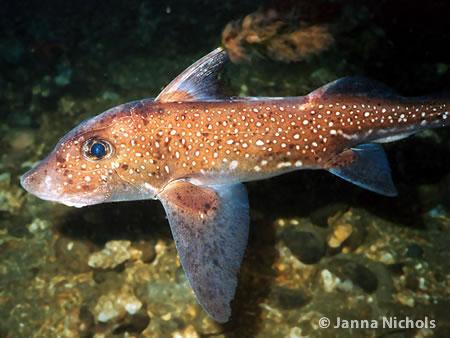Caught incidentally in the commercial fishery off the Washington coast with otter-trawls and longline gear. Commonly caught incidentally by recreational harvesters off the outer Washington coast and in Puget Sound.
The genus of the spotted ratfish (Hydrolagus)means water bunny. The club-line appendage on the forehead of male spotted ratfish, called a clasper, is used during mating to grip the female, typically on the pectoral fin, and aid in ensuring copulation occurs.
Description and Range
Physical description
The long, tapering body of the spotted ratfish is silvery or brownish, often with iridescent shadings of gold, green and blues. It has white spots along the back and sides. The head is large and rabbitlike with large green eyes. There is one pair of teeth in the lower jaw and two pairs of teeth in the upper jaw, occurring as mineralized grinding plates. Spotted ratfish have prominent lateral line canals on unscaled slippery skin and a large spine at the front of the first short dorsal fin. The pectoral fin is large, triangular, and has a fleshy base. Both the caudal and dorsal fins are dark-edged. Males have a clublike appendage on their forehead. Spotted ratfish typically swim using a rowing motion of their pectoral fins, rather than with their tails, and can often be distinguished underwater by this distinct mode of motion.
Spotted ratfish can grow up to 60 cm (23.6 in) in length.
Geographic range
Spotted ratfish range from southeast Alaska to Baja and the northern Gulf of California. They are common off B.C. to northern California. They can most commonly be found living near the bottom on sand, mud or rocky reefs. They are found close inshore from Washington northward and deeper southward. They range in depths from 0 to 910 m (0-3,000 ft).
State record
- Weight
- 3.90 lbs
- Angler
- William J. Denning
- Location
- Hein Bank
- Date Caught
- July 19, 1996
